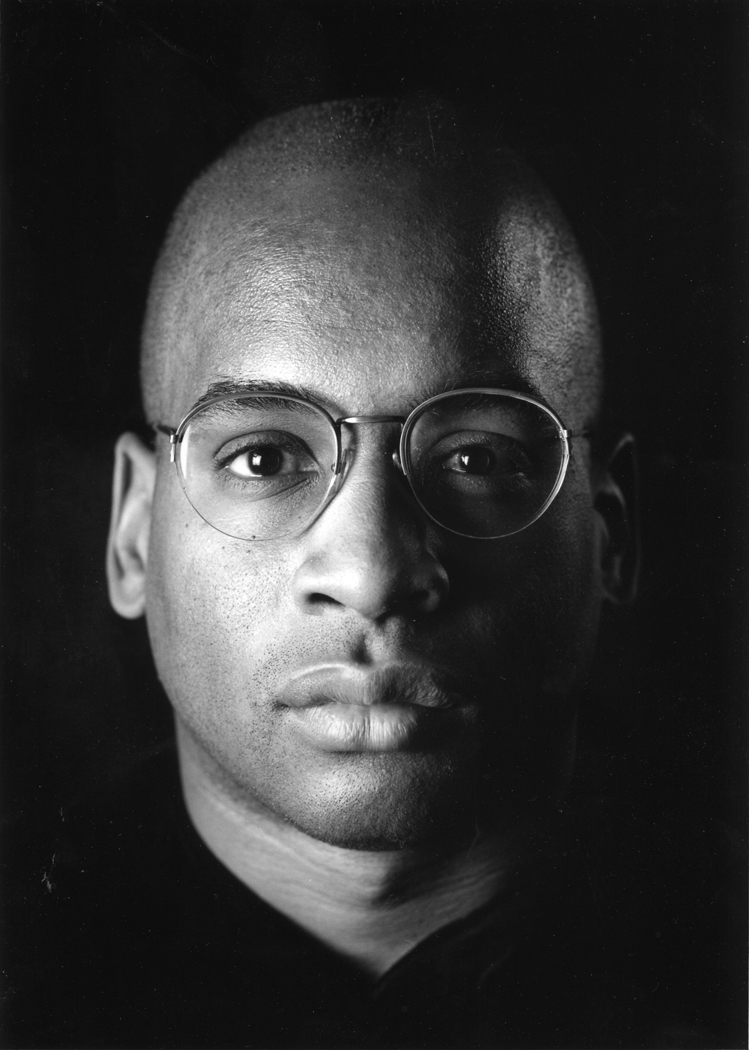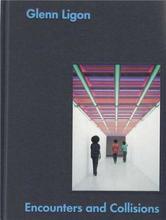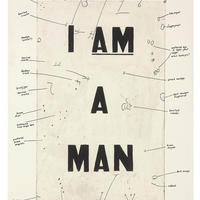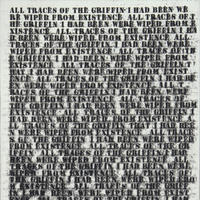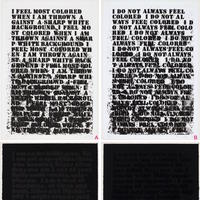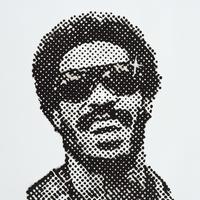More about Glenn Ligon
- All
- Info
- Shop

Contributor
Glenn Ligon is kind of like a mash-up artist putting Biggie lyrics over Miley Cyrus songs, except he uses James Baldwin’s words and puts them on a different kind of blank, white canvas.
He actually does mash-ups with music too, like speakers playing Billie Holiday’s rendition of “Strange Fruit” from inside of a crate like the one that Henry “Box” Brown used to escape from slavery via the USPS, a party anthem for the ages.
He’s still a young dude (like, for an artist) and the Bronx taught him how to go hard in the paint. (lol, get it? Paint?) Or more accurately, his parents taught him to go hard on self-improvement, like reading books, liberal arts college, working in law, getting that paper; eventually he had to “come out as an artist.”
For real though, Ligon is all about having a good time. Like when he wanted to explore the way historical figures change over time he hung out with a bunch of elementary school kids and gave them Black Power coloring books, with the cryptic explanation that “kids love to deface father figures.” Or that other time when he was asked to curate a show about himself and his influences, he used it as an excuse to hit up artists that he wanted to work with. His whole art world presence is like those sad parties where everybody is having a really good time while also acknowledging that the void is present and getting closer and bigger all the time, you went to those too right?
Ligon loves flirting with the void; he once shot an entire movie on improperly loaded film, then used only the most blurry, shadow-ridden shots and called it a success. Or actually he called it a failure that “was in line with [his] larger artistic project.” Hello darkness, my old friend.
The secret to Ligon’s success is probably that darkness is everybody’s old friend. The Obama White House acquired Ligon’s Black Like Me #2 on loan and hung it in the living quarters. The painting repeats the words “all traces of the Griffin I had been were wiped from existence” as they descend into a mess of black paint abstraction, a friendly reminder for the First Fam that it’s always a good time to ask: ugh, what kind of party is this anyway?
Sources
- Drohojowska-Philp, Hunter. December 11, 2009. “Glenn Ligon gets Obama’s vote.” Los Angeles Times, December 11, 2009. Accessed Aug 7, 2017. http://articles.latimes.com/2009/dec/11/entertainment/la-et-glen-ligon1…
- Forrest, Nicholas. “Glenn Ligon on His ‘Encounters and Collisions’ in Nottingham.” Blouin Artinfo, April 10, 2010. Accessed August 3, 2017. http://www.luhringaugustine.com/attachment/en/556d89b2cfaf3421548b4568/…
- Ficpatrik, Milja. “Biography: Glenn Ligon.” Widewalls, 2017. Accessed August 3, 2017. http://www.widewalls.ch/artist/glenn-ligon/
- Moran, Jason. “Glenn Ligon.” Interview Magazine, June 8, 2009. Accessed August 1, 2017. http://www.interviewmagazine.com/art/glenn-ligon/print/
- Weekend Edition Sunday. May 8, 2011, 7:14 am ET. “Glenn On The Coloring Book Image That Inspired ‘Malcolm X’.” National Public Radio. Accessed August 1, 2017.

Contributor
Besides being an artistic pioneer for the gay, black experience, Glenn Ligon is also here to remind us that people seriously need to start reading more books.
If it weren't for the National Endowment for the Arts, Glenn Ligon would not be an artist - or so he claims. In recent history the NEA has caught a bit of flack from the conservative right for funding controversial work such as that of Robert Mapplethorpe and David Wojnarowicz, and has since lost the ability to support artists as freely as they once did. Ligon was right on the cusp of all this drama when he received his grant in 1989 (back when the NEA used to fund individual artists). It was this grant that allowed him to take time off work to explore his potential as an artist; needless to say, he never went back to the 9-5 grind. Ligon reasoned, “if the government thinks I’m an artist, then I must be one,” because our government is known to be highly on point and trustworthy. Nonetheless, I would say this is a great use of our tax dollars; surely the galleries that represent Ligon think so too!
There is no denying that Ligon is a total bookworm. Growing up in the Bronx with little disposable income, Ligon was only allowed to spend money on things that would further his intellect. Books and trips to the Met were commonplace, but stuntin some sweet Air Jordan shoes was not an option. So he fell deep into the cultural and literary rabbit hole from a young age. Today, Ligon utilizes racially charged prose from some of his favorite authors such as Gertrude Stein and Ralph Ellison to combat the social stigmas of race and homosexuality.
Early on, Ligon aspired to be an abstract expressionist. That was until he realized he did not care about what he had to say, but rather was interested in what society had to say. He realized he was not nearly into himself enough to be abstract expressionist artist and since has shifted his focus to history at large. As Ligon put it, “It’s not about me,” he says. “It’s about we.”
His work investigates a range of topics including gayness, language, and desire, but most notably he explores the history and identity of African American people. Considering his interest in black history, it seems perfectly fitting that the Obama’s are big fans of Ligon’s work and even hung one of his pieces in their private corridors when they were taking up residence in the White House. Between this and Ligon’s connection with the NEA, we can only image how Trump felt during his first stroll through the presidential palace.
Sources
- Moran, Jason. "Glenn Ligon." Interview Magazine. August 06, 2009. Accessed June 05, 2017. http://www.interviewmagazine.com/art/glenn-ligon/#_.
- Schjeldahl, Peter. "Unhidden Identities." The New Yorker. March 21, 2011. Accessed June 05, 2017. http://www.newyorker.com/magazine/2011/03/21/unhidden-identities.
- Vogel, Carol. "The Inside Story on Outsiderness." The New York Times. February 26, 2011. Accessed June 05, 2017. http://www.nytimes.com/2011/02/27/arts/design/27ligon.html.
- "Glenn Ligon." Art21. Accessed June 05, 2017. https://art21.org/artist/glenn-ligon/.
- "Glenn Ligon in "History"." Art21. Accessed June 05, 2017. https://art21.org/watch/art-in-the-twenty-first-century/s6/glenn-ligon-….
Featured Content
Here is what Wikipedia says about Glenn Ligon
Glenn Ligon (born 1960, pronounced Lie-gōne) is an American conceptual artist whose work explores race, language, desire, sexuality, and identity. Based in New York City, Ligon's work often draws on 20th century literature and speech of 20th century cultural figures such as James Baldwin, Zora Neale Hurston, Gertrude Stein, Jean Genet, and Richard Pryor. He is noted as one of the originators of the term Post-Blackness.
Check out the full Wikipedia article about Glenn Ligon

